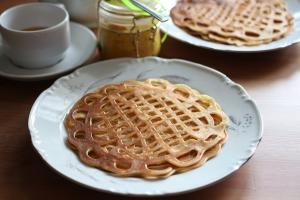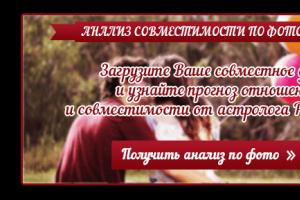Can a fairy tale that everyone knows from childhood surprise? Many people have several editions of the fairy tale “Kolobok” at home. The plot is unambiguous, all the characters are known, there are no extended versions, unlike “Ryaba the Hen”. No surprises. The most that a publishing house can do is to attract parents and children with beautiful illustrations.
But it turned out that there is room for an interesting option here too!
Publishing house "Karapuz" and "TC Sfera" published a fairy tale "Kolobok" in the series "For the very little ones" with additional title "Comparison, magnitude". I decided that there would be instructions for parents, and in it there would be a recommendation to explain to the child the concepts of “small, big, very big” using the example of fairy tale characters. And so it turned out. But this is not the main surprise and surprise.
The bun, as expected, is always the same size. And other characters in the book, like the book itself, change in size.

The bunny with a carrot is small, slightly larger than the bun itself. But the wolf is already bigger. The bear is quite big. The fox, as expected, is slightly smaller than the wolf.

The book does not leaf through as usual, but gradually unfolds. And her heroes change in size along with her. The last cover page is flap to reflect the size of the fox.

I really liked this approach, and it was a complete surprise for me!
In addition, the book has beautiful illustrations by Tatyana Dubinchik. So “classic”, with funny and easily recognizable animals. For the last 5 years, Tatyana has been making very cute and kind toys. Look how lovely it is!
There are both separate instructions for parents and tips as you read. The authors of the series recommend not only reading the book and retelling it, but also sculpting characters, drawing them, and a little later – organizing theatrical performances.

So it's a fairy tale “Kolobok.” Comparison, magnitude" turned out to be a pleasant surprise for me.
Read good books!
What you can read about in the article:
- What does Kolobok look like in fairy tales?
- Was the donut a prototype of Kolobok?
- Was bread the prototype of Kolobok?
- How does Kolobok stand for?
- How could the fairy tale about Kolobok appear?
Kolobok is a Russian folk hero. Its image is as follows: a round ball, edible, made of flour, is a delicious bread with a crispy golden brown crust. The kolobok was made in an oven.
Who or what was the prototype of Kolobok
I remembered donuts, they are also rosy, round, crispy, but fried in hot oil in a frying pan. At the same time, donuts are a sweet dish, and bread is unleavened. It turns out that the donut was not the prototype of the kolobok.
Let's return to bread, was it possible in Rus' before to bake bread that would be a round ball, like a bun? All the pictures with peasants depict round hearth bread, fluffy, tall, but lying tightly on the surface; there is no talk of any ball. However, if you make bread from a very tight dough that rises quickly and does not have time to spread, leaving the shape of an almost perfect ball, you get almost a bun!
How they baked bread in Rus'
Then the story develops like this: the peasants put the bread to cool on the windowsill (reminds me of something?), in the draft the bread took on a strong crispy crust. It was easy to roll such a piece of bread, just put it on the edge, it was round, like a car wheel, and let it go down the hill - the bread rolled to the bottom, bouncing on the bumps like a ball, while remaining intact!
Now the decoding of the name: kolo - circle, side side. Round side. Ordinary hearth bread, modern, has a flat side with a sharp edge, such an edge will not roll anywhere, it is no longer a bun, but a round bread with a slightly raised top.
Yes, this is ordinary Russian bread and it was invented by those who needed to put their children to bed. Could bread "escape"? It’s easy if someone accidentally pushes it off the windowsill, but to speed up the cooling, the bread was placed on its edge, that is, on its side., from which the bread could easily move and roll away from any jump or push (suddenly a cat was running there).
Everyone knows the folk tale about Kolobok, but few know what it is - “ bun" In the fairy tale, this character is represented in the form of round bread. He escaped from his grandmother and grandfather, who baked him, outwitted the hare, wolf and bear, but was still eaten by a fox. So what kind of character is this Kolobok? Is there spherical bread?
It turns out that kolobok is a traditional round flatbread in ancient Rus'. Other names for kolobok - kolobukha, kalabushka, kolobushka. Kolobukha or kolobok is a round flatbread that had a spherical shape. This shape was achieved through the process of preparing bread from a mixture of different types of flour.
If you remember how the “grandmother and grandfather” prepared the kolobok, you can find out the basic recipe for preparing this dish - to prepare the kolobok, the grandmother “scraped the box and broomed the bottom.” It turns out that kalabushki were baked precisely from the remains of various flours (wheat, rye, oatmeal, etc.) and the remains of kneading. Due to the fact that the kolobok was a mixture of different types of flour, the proportion of leaven in the kolobok, according to the laws of biochemistry, always exceeded the proportion of leaven in bread made from homogeneous flour. Heterogeneous flour gave an extraordinary effect. The bread turned out to be extremely fluffy, fluffy, soft, and baked. It was the combination of various types of flour that contributed to the rise of the flatbread, which by the end of cooking turned into a real ball. This bread had a special taste and did not go stale for a long time. It was on the basis of this product that the fairy tale about the revived Kolobok was invented.
One can even guess how folk imagination came up with the original plot of a well-known work. It is likely that the person who first came up with this story cooked or witnessed the preparation of kolbukha. Because of its round shape, the bun could, as if alive, roll off the table onto the floor, which led to the creation of a funny fairy tale about how bread escapes from grandparents.
Another interesting thing about the tale about Kolobok is that, apparently, this plot was invented a very, very long time ago. Surprisingly, a similar story about runaway round bread exists in many countries around the world. There are similar tales in Uzbek, Tatar, German, Scandinavian, English and other folk works. In fairy tales of different peoples of the world, the runaway bread experiences different adventures (in the Norwegian version he is eaten by a pig, and in German he gives himself up to be eaten by three orphans), but their basis is very similar (round bread runs away from those who baked it, and a long time is saved from various animals until he is eaten), which may lead to the idea that the tale of Kolobok was invented in very ancient times and was subsequently preserved among different peoples who were formed from one ancestral people.
Gingerbread Man cartoon:
Do you like to listen to your favorite music in the best quality? In this case, monster beats headphones are exactly what you need. Incredible performance, perfect sound and stylish design.
What does it seem at first glance?
Background
In Rus', with the advent of writing, literature began to develop. This happened back in the 9th century. However, it is a mistake to assume that nothing like this had happened before this moment. Literature simply existed in a different form. It was oral and was not recorded anywhere in writing. People passed on legends, various stories, proverbs, and songs to each other. Folklore is considered one of the most colorful sections of Russian literature. Therefore, it is logical that readers have a question: who wrote the fairy tale about Kolobok? The answer is simple: it does not have a specific author. This is a story invented by the people and passed on from mouth to mouth. Fortunately, it has survived to this day. Only in a somewhat transformed form, because each storyteller added something of his own to it.
How did it all begin?
The story about the little pie who was not afraid of anything is very simple. The tale about Kolobok begins with a description of the poor family of his grandfather and grandmother. Based on the description, we can assume that the events take place in the summer. The harvest harvested in the fall was probably eaten, but the new one is still far away. But I want to eat. And the grandfather asks the grandmother to bake him a bun. Where can I get flour? But the old people are not discouraged, they decide to scrape through the bottom of the barrel and find some remains.
After the work is done, the grandmother ends up with two handfuls of flour. She kneads them with sour cream (after all, there was not exactly hunger in the house), makes the dough and makes a bun.
After baking, the old woman decides to cool it before serving it to her grandfather.
But then something magical happens: the flour product comes to life, sees that it is lying on the open window, and immediately takes the opportunity to escape. Why did Kolobok do this? It's not hard to guess: he doesn't want to be eaten by his owners.
The fairy tale about Kolobok, the meaning of which is to show the fearlessness of the protagonist, takes a new turn. The running “pie” rolls through the forest wherever the eyes look. And here new dangers await him.
Fearless Kolobok

He rolls merrily through the forest, singing songs. And then a hare comes towards him. This is the most good-natured animal of all that he will meet later. But he also threatens to eat Kolobok. The cunning hero realized that he could avoid danger by offering a deal to the hare - to sing a song. After that, he quickly runs away from him, pleased with himself.
He praises himself very much and rejoices in his exclusivity. After all, it was baked from the last flour, mixed with sour cream, and cooled in the window.
The tale about Kolobok continues with the meeting of a large forest animal - a bear. It seems that this meeting will not bring anything good. Since ancient times, bears have been considered the strongest among other animals. But the smug Kolobok sings his song to him and quickly runs away.
After this meeting, we think, our hero has nothing to fear. But it was not there.
Sad ending

The unsuspecting Kolobok continues his journey. And then a fox comes across him. What an interesting approach she takes to Kolobok! The fox praises his song and gives him compliments. And then our hero completely lost his vigilance. He is inspired by previous victories over all the characters, starting with his grandfather and grandmother. Now he is not at all afraid of some fox. Besides, she is so kind and affectionate. But the cunning forest dweller turned out to be more perspicacious than Kolobok. She pretended to be deaf and asked him to sing his song on her face so that he could hear her better.
How does the tale about Kolobok end? Quite unexpectedly: a sly fox eats our brave hero.
Conclusion
It is worth saying that the ending of this tale is still predictable. Kolobok became very self-confident and completely stopped being afraid of anyone. And so he falls into the trap of a resourceful fox.
This story teaches us to be more vigilant, to fear not only strong enemies, but also cunning ones.

About Kolobok is quite simple. There is a lot of dialogue in it, so it will be enough to attract one person to read the words of the author, and assign everyone else to roles. The main lines go to Kolobok, and they are almost the same.
If you want to act out this fairy tale, for example, in a literature lesson, it will not be difficult.
Once upon a time there lived an old man and an old woman.
So the old man says to the old woman:
- Come on, old woman, scrape along the box, mark along the bottom, see if you can scrape some flour into a bun.
The old woman took the wing, scraped it along the box, swept it along the bottom and scraped up two handfuls of flour. She kneaded the flour with sour cream, made a bun, fried it in oil and put it on the window to cool.
The gingerbread man lay there, lay there, took it, and then rolled - from the window to the bench, from the bench to the floor, along the floor to the door, jumping over the threshold - and into the entryway, from the entryway to the porch, from the porch to the yard, from the yard through the gate, on and on. further.
A bun rolls along the road and a hare meets it: 

Don't eat me, hare, I'll sing you a song:
I am a bun, a bun,
I'm scraping the box
By the end of the day it's swept away,
Mechon on sour cream
Yes, there is yarn in butter,
There is a chill on the window.
I left my grandfather
I left my grandmother
I'll be leaving you, hare!
And he rolled down the road - only the hare saw him!
The bun rolls, a wolf meets it:
Kolobok, Kolobok, I will eat you!
Don't eat me, gray wolf, I'll sing you a song:
I am a bun, a bun,
I'm scraping the box
By the end of the day it's swept away,
Mechon on sour cream
Yes, there is yarn in butter,
There is a chill on the window.
I left my grandfather
I left my grandmother
I left the hare
I'll leave you soon, wolf!
And he rolled down the road - only the wolf saw him!
The bun rolls and a bear meets it:
- Kolobok, Kolobok, I will eat you! 
- Where can you, clubfoot, eat me! Better listen to my song:
I am a bun, a bun,
I'm scraping the box
By the end of the day it's swept away,
Mechon on sour cream
Yes, there is yarn in butter, 
There is a chill on the window.
I left my grandfather
I left my grandmother
I left the hare
I left the wolf
I'll leave you soon, bear!
And he rolled again - only the bear saw him!
The bun rolls and the fox meets it:
- Kolobok, Kolobok, where are you going?
- I'm rolling along the path.
- Kolobok, Kolobok, sing me a song!
Kolobok sang:
I am a bun, a bun,
I'm scraping the box
By the end of the day it's swept away,
Mechon on sour cream
Yes, there is yarn in butter,
There is a chill on the window.
I left my grandfather
I left my grandmother
I left the hare
I left the wolf
Left the bear
It’s not smart to get away from you, fox!
And the fox says:
- Oh, the song is good, but I can’t hear well. Kolobok, Kolobok, sit on my toe and sing one more time, louder.
The gingerbread man jumped up on the fox's nose and sang the same song louder.
And the fox told him again:
- Kolobok, Kolobok, sit on my tongue and sing for the last time.
The bun jumped on the fox's tongue, and the fox made a noise! - and ate it.
Russian folktale








